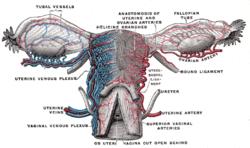| Cardinal ligament | |
|---|---|
 Vessels of the uterus and its appendages, rear view. (Cardinal ligament not visible, but location can be inferred from position of uterine artery and uterine vein.) | |
 Uterus and right broad ligament, seen from behind. (Cardinal ligament not labeled, but broad ligament visible at center.) | |
| Details | |
| Identifiers | |
| Latin | ligamentum cardinale, ligamentum transversum cervicis, ligamentum transversalis colli |
| TA98 | A09.1.03.031 A09.1.03.022 |
| TA2 | 3839 |
| FMA | 77064 |
| Anatomical terminology | |
The cardinal ligament (or Mackenrodt's ligament,[1] lateral cervical ligament, or transverse cervical ligament[2]) is a major ligament of the uterus. It is located at the base of the broad ligament of the uterus. There are a pair of cardinal ligaments in the female human body.
Structure
The cardinal ligament is a paired structure on the lateral side of the uterus. It originates from the lateral part of the cervix.[3] It attaches to the uterosacral ligament.[3]
It attaches the cervix to the lateral pelvic wall by its attachment to the Obturator fascia of the Obturator internus muscle, and is continuous externally with the fibrous tissue that surrounds the pelvic blood vessels. It thus provides support to the uterus.[4] Additionally, it carries the uterine arteries to provide the primary blood supply to the uterus.
Clinical significance
The cardinal ligament may be affected in hysterectomy.[5][6] Due to its close proximity to the ureters, it can get damaged during ligation of the ligament. It is routinely cut during some uterine operations, although this can have side effects.[3]
See also
References
This article incorporates text in the public domain from page 1261 of the 20th edition of Gray's Anatomy (1918)
- ^ Netter, Frank H. (2003). Atlas of Human Anatomy, Professional Edition. Philadelphia: Saunders. p. 370. ISBN 1-4160-3699-7.
- ^ Anatomy Labs #12 & 13
- ^ a b c Ito, E.; Saito, T. (December 2004). "Nerve-preserving techniques for radical hysterectomy". European Journal of Surgical Oncology (EJSO). 30 (10): 1137–1140. doi:10.1016/j.ejso.2004.06.004. ISSN 0748-7983.
- ^ Kyung Won, PhD. Chung (2005). Gross Anatomy (Board Review). Hagerstown, MD: Lippincott Williams & Wilkins. p. 274. ISBN 0-7817-5309-0.
- ^ Kato T, Murakami G, Yabuki Y (2002). "Does the cardinal ligament of the uterus contain a nerve that should be preserved in radical hysterectomy?". Anat Sci Int. 77 (3): 161–8. doi:10.1046/j.0022-7722.2002.00023.x. PMID 12422408.
- ^ Kato T, Murakami G, Yabuki Y (2003). "A new perspective on nerve-sparing radical hysterectomy: nerve topography and over-preservation of the cardinal ligament". Jpn J Clin Oncol. 33 (11): 589–91. doi:10.1093/jjco/hyg107. PMID 14711985.
External links
- figures/chapter_35/35-5.HTM: Basic Human Anatomy at Dartmouth Medical School
- part_6/chapter_35.html: Basic Human Anatomy at Dartmouth Medical School